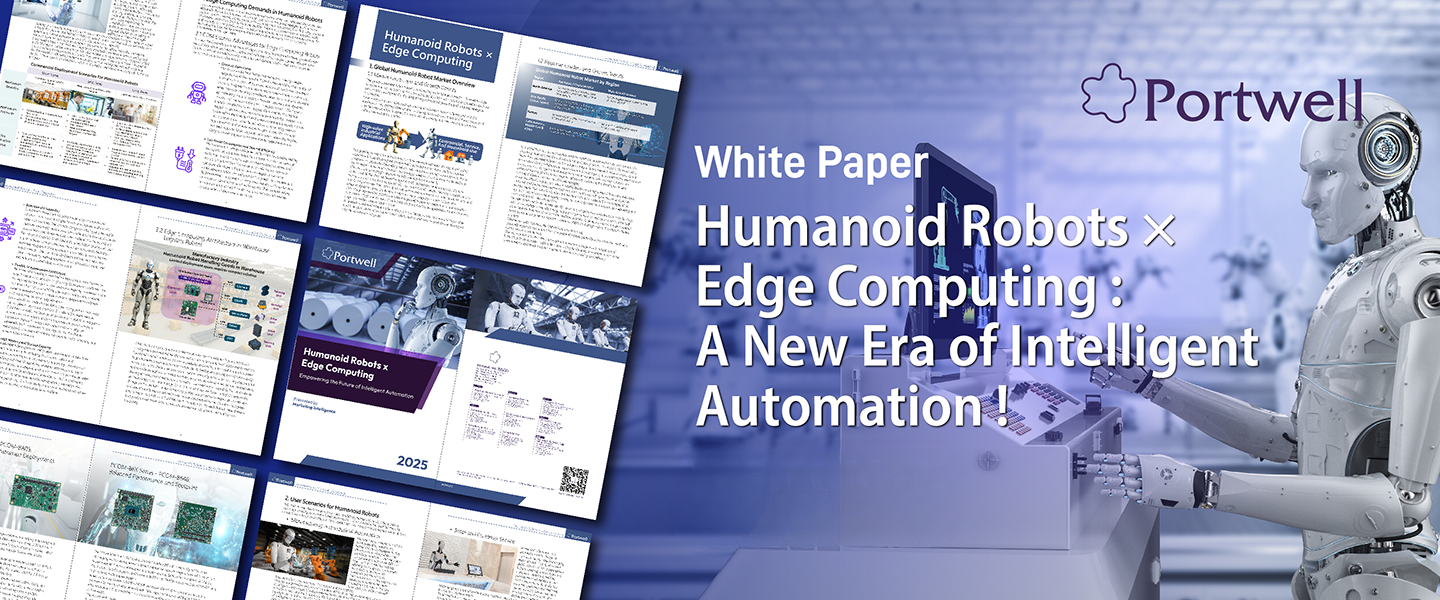
The global humanoid robot market is undergoing a pivotal transformation, from early-stage innovation to accelerated commercial expansion. By 2030, the market is projected to reach the tens-of-billions range (USD), signaling strong commercial potential and solid technological momentum.
Several key forces are driving this growth: rapid advancements in robotics and artificial intelligence (AI), shifting demographics, evolving economic structures, and the emergence of new business models. Together, these trends are ushering in a new era of human-robot collaboration across industries.

The growing demand for automation, combined with global labor shortages and aging populations, is accelerating the adoption of humanoid robots, particularly in high-risk, repetitive, or physically demanding sectors such as manufacturing and logistics. In these environments, humanoid robots are increasingly viewed not just as tools for operational efficiency, but as strategic solutions to critical workforce bottlenecks.
At the core of this shift are breakthroughs in artificial intelligence and robotics. Modern humanoid robots are now equipped with advanced AI and machine learning capabilities that significantly enhance their ability to interact with humans, interpret complex environments, and adapt to dynamic tasks. Continuous progress in large language models (LLMs) and vision-language models (VLMs) has further improved robotic perception and task execution. These technological leaps are not only expanding the functional capabilities of robots but also helping to reduce overall system costs.
As a result, humanoid robots are beginning to move beyond niche research and high-value industrial applications into broader commercial, service, and even household use, paving the way for mainstream adoption.

The global humanoid robot market exhibits significant regional diversity, with each region driven by distinct technological, economic, and policy factors. As of 2024, North America leads the humanoid robotics sector, supported by a robust research infrastructure, strong university-industry collaboration, rapid technological progress, and substantial investments in robotics and AI. Its open innovation environment and abundant venture capital have attracted leading players to the region, collectively advancing the development and commercialization of core robotics technologies.
In the Asia-Pacific region, growth is primarily driven by strong demand from countries such as China and Japan, along with proactive investment from both government and private sectors. Japan has actively introduced humanoid robots to address the challenges of an aging society, while China is rapidly scaling up due to government support and advantages in cost control and mass production.
Europe stands out in the service robotics segment, propelled by consistent research funding, a focus on intelligent manufacturing, and a strong emphasis on ethical and safety standards. While its overall market share remains relatively modest, its deep involvement in professional applications and regulatory support is helping solidify its strategic role in the global robotics industry.
Meanwhile, Latin America, the Middle East, and Africa are gradually expanding their adoption of humanoid robots, particularly in hospitality, retail, and public service environments.
Overall, regional growth in the humanoid robot market is shaped by a unique mix of technological ecosystems, societal demands, policy landscapes, and stages of economic development, collectively forming a dynamic and multifaceted global industry.
With their human-like form and movement capabilities, humanoid robots offer a unique advantage in navigating unstructured environments. Their versatility has enabled them to evolve from conceptual prototypes to practical tools with transformative impact across sectors.
Short-Term | Mid-Term | Long-Term | |
|---|---|---|---|
Manufacturing and Logistics Automation | Retail, Education, and Interactive Services | Healthcare and In-Home Assistance | |
Application Domains | 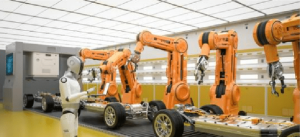 |  |  |
Application Scenarios |
|
|
|
Key Application Focus |
|
|
|
Humanoid robots require real-time perception and environmental understanding to operate effectively. To achieve this, they rely on high-precision sensing technologies such as tactile sensors, depth cameras, LiDAR, and inertial measurement units (IMUs) to collect large volumes of environmental data. Edge computing enables these data streams to be processed locally and instantly, ensuring data privacy, operational continuity, and real-time responsiveness. This architecture is essential for precise environmental perception and motion control in autonomous robot operations.

Humanoid robots have limited internal space, making compact computing modules essential. COM Express modules, often designed in Small Form Factor (SFF) layouts, enable high performance without compromising mechanical design. Many feature fanless construction, which improves durability by reducing exposure to dust and vibration. By minimizing size and weight, robots can achieve better dynamic stability and maneuverability across complex terrain. COM Express modules are ideal for these compact deployments, offering high integration, performance, and configuration flexibility. Compared to traditional motherboards, COM Express combines a compute module with a customizable carrier board, allowing dense integration of high-speed I/O and AI accelerators in tight spaces. This modular approach supports future upgrades and system scalability, helping designers balance spatial constraints with functional expansion.

Humanoid robots are typically powered by onboard batteries, making energy efficiency a critical design factor. Systems must maintain high performance while minimizing power draw to extend runtime and avoid thermal throttling. Overheating not only reduces inference speed but also impacts the execution of complex movements. COM Express modules are designed for low power consumption and flexible thermal management, making them suitable for long-duration operations in space-constrained environments. Their wide operating temperature support (−40°C to 85°C) ensures reliable performance across a variety of deployment scenarios.
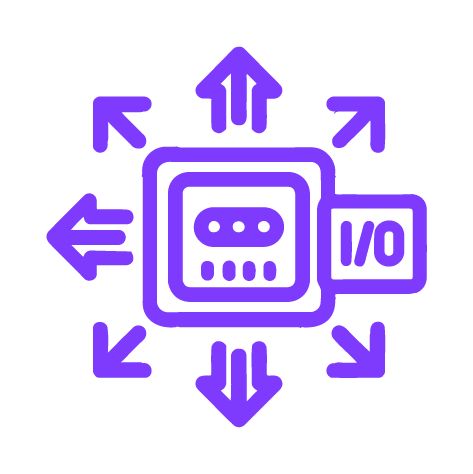
Humanoid robots must integrate a wide array of sensors and actuators. This requires a highly flexible and high-throughput I/O expansion capability. The modular design of COM Express decouples computing from I/O, enabling custom carrier boards to extend a broad array of interfaces. These modules offer multiple PCIe lanes, USB 3.2 Gen 1/Gen 2, Gigabit/2.5GbE/10GbE Ethernet, HDMI®, DisplayPort, and industrial buses such as CAN bus. This broad connectivity facilitates real-time integration of subsystems, reduces latency, and enhances responsiveness. The use of standardized interfaces also increases system modularity, making upgrades or reconfiguration easier and extending the overall lifespan of the robot.
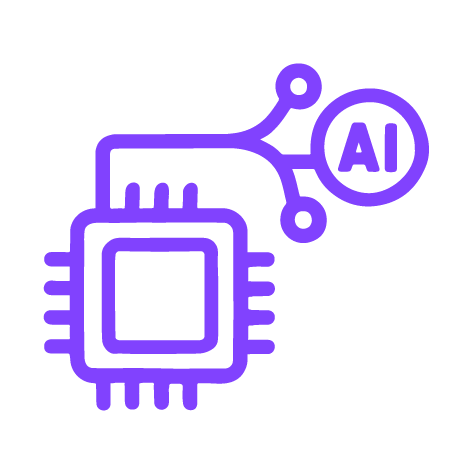
Real-time AI processing is essential for tasks such as visual inference, speech recognition, and motion planning. COM Express platforms can be engineered to support heterogeneous computing architectures that combine CPUs, GPUs, and NPUs (neural processing units), enabling dynamic workload allocation based on task complexity to optimize both performance and energy efficiency. More specifically, while discrete GPUs offer strong performance, they can be power- and space-intensive. To address this, many modern COM Express platforms leverage AI acceleration capabilities integrated directly into the processor and/or incorporate processors based on system-on-chip (SoC) designs that support efficient edge AI workloads. Such architecture is well aligned with the diverse requirements of humanoid robots in perception, motion planning, and human-robot interaction.
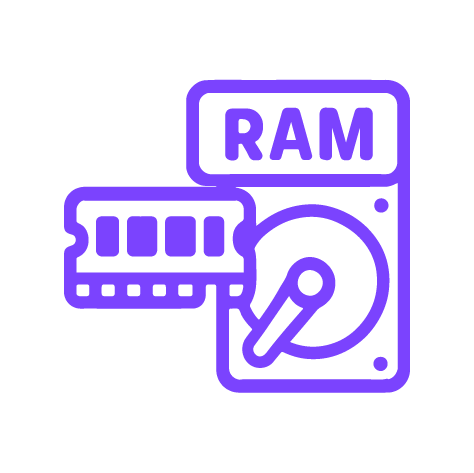
Humanoid robots generate and process vast amounts of data from various sensor inputs, including vision, audio, tactile, and proprioception. High-capacity memory and storage are critical for enabling real-time AI algorithms, environmental mapping, object reconstruction, and adaptive control. Local memory and storage allow robots to store relevant data and AI models on-device, minimizing reliance on cloud services and eliminating latency associated with remote processing. This is especially important in environments where network connectivity is intermittent or unavailable.
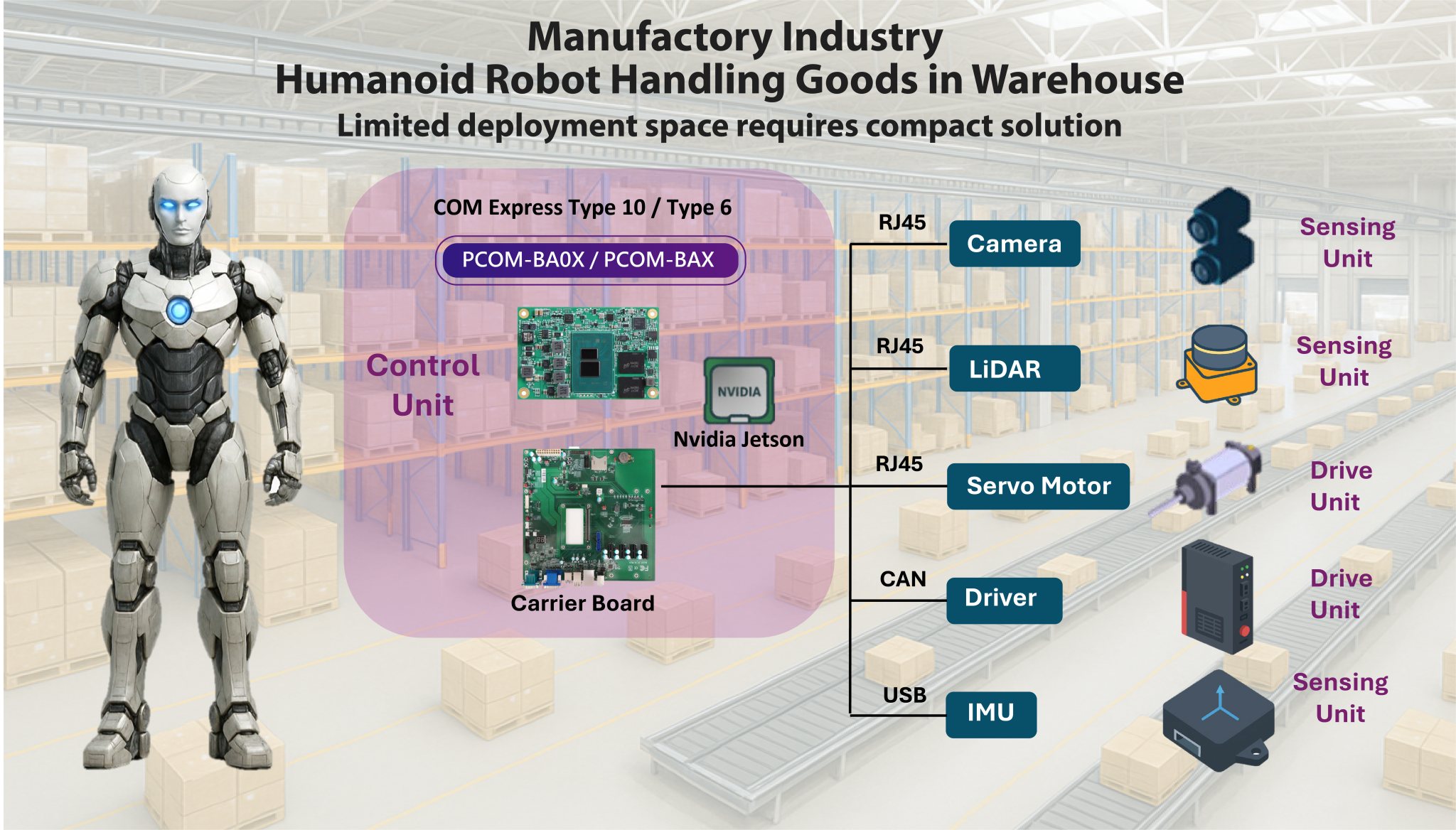
Driven by the surge in global e-commerce and the rise of intelligent logistics, warehouse management and material handling operations are undergoing rapid digital transformation. Traditional manual workflows are being gradually replaced by automated transport systems, beginning with today’s autonomous mobile robots (AMRs) and moving toward future-ready humanoid robots. These next-generation systems are designed to meet growing demands for higher order throughput, real-time inventory accuracy, and dynamic warehouse orchestration.
Among all categories of warehouse automation, transport robots especially humanoid robots are increasingly seen as a strategic focus that could shape the future of logistics worldwide.
To support this evolution, edge computing platforms must deliver compact, power-efficient, and scalable performance tailored to the unique demands of humanoid robots in logistics environments. The following COM Express® modules from Portwell illustrate how different configurations can meet varying levels of performance, integration, and deployment complexity.
The humanoid robot market continues to demand high-precision, low-latency processing and seamless integration of diverse sensors. Portwell’s PCOM-BA03, part of the COM Express® Type 10 family, offers a compact computing solution with a footprint of just 84 x 55 mm, ideal for integration into the head or torso of humanoid robots in space-limited embedded applications.
With a processor TDP of just 6W to 12W and industrial-grade temperature support for −40°C to 85°C, the PCOM-BA03 is designed for fanless or sealed environments, preventing thermal throttling and ensuring stable performance provides 4x PCIe Gen3 lanes, 10x USB (2.0/3.2), 2x SATA ports, Intel® I226 Ethernet, and 4K-capable display interfaces.
The corresponding carrier board supports integration with depth cameras, LiDAR, IMUs, and motion control modules. While not intended for highly scalable configurations, the module’s built-in connectivity is sufficient for basic sensing, vision, and networking tasks. It enables advanced path planning, real-time collision avoidance, and precision handling of goods. Powered by Intel®Atom® x7000E/x7000RE series processors with up to 32EU integrated GPU, the PCOM-BA03 is well-suited for lightweight edge AI inference workloads such as image classification and object detection. Although it does not include a built-in NPU, it can be paired with external accelerators to meet the requirements of light-duty intelligent tasks. Onboard LPDDR5 memory (up to 16GB) and eMMC storage (up to 256GB) with In-Band ECC further reduce cabling complexity and enhance vibration resistance ideal for mobile, multi-axis robotic platforms.
The PCOM-B646 is a COM Express Compact module (95 x 95 mm) designed for more demanding environments, with industrial temperature support ranging from −40°C to 85°C. It features robust thermal performance and supports up to 6x PCIe Gen3 x1 lanes, 4x USB 3.2 Gen2 ports, 2x SATA III ports, and Intel® I226 Ethernet. Display output via DDI, eDP/LVDS, and VGA enables multi-display support.
Powered by Intel Atom® x7000E/x7000RE and Intel® Core™ i3 N-series processors, it is optimized for mid-level edge AI workloads. With support for up to 48GB DDR5 SO-DIMM at 4800 MT/s (non-ECC), it enables more complex AI models and data-intensive tasks than the PCOM-BA03.
The PCOM-B646 strikes a balance between computing performance and compact size, making it well-suited for logistics robots that require moderate AI inference, vision processing, and real-time analytics.
The PCOM-B65A is a COM Express Basic module (125 x 95 mm) designed for deployment in the core processing units of advanced humanoid robots. Although it draws more power than Atom-based modules (15W to 28W), the Intel® Core™ Ultra platform enables energy-efficient performance, even under limited cooling conditions.
The module features up to 24 PCIe Gen4 lanes, 4x USB 3.2 Gen2, 8x USB 2.0, and 2x SATA III ports. It also provides multi-display interfaces, including HDMI®, VGA, eDP/LVDS, and DDI. Its high-bandwidth I/O supports high-resolution cameras, radar modules, haptic feedback systems, AI accelerators, and storage units. Its high bandwidth I/O ensures responsiveness in complex perception and motion control tasks.
Equipped with up to 128EU Intel® Arc™ GPU and a built-in NPU (Neural Processing Unit), the PCOM-B65A supports parallel AI workloads such as visual analysis, semantic understanding, and decision inference. This heterogeneous CPU+GPU+NPU architecture enables real-time “sense-decide-act” capabilities, critical for autonomous operation in dynamic warehouse environments.
With support for up to 96GB DDR5 5600 MT/s SO-DIMM memory and onboard PCIe NVMe SSD options, the PCOM-B65A is built for large-scale AI models, 3D perception algorithms, and sensor data caching. It serves as a high-performance foundation for advanced or multi-role humanoid robot missions.
| Compact and Efficient for Space-Constrained Deployments | Optimized Performance in a Compact Footprint | High-Performance Computing for Demanding Deployments |
| PCOM-BA03 | PCOM-B646 | PCOM-B65A |
| Type 10 Mini COM Express* 84 × 55 mm |
Type 6 Compact Size COM Express* 95 × 95 mm |
Type 6 Basic Size COM Express* 125 × 95 mm |
|
|
|
| Integrated GPU for lightweight AI tasks such as basic image recognition and sensor fusion | Integrated GPU for moderate AI workloads including multi-camera vision and real-time analytics | High-performance CPU with Arc™ GPU and NPU for complex AI workloads, including multi-modal perception and real-time inference |
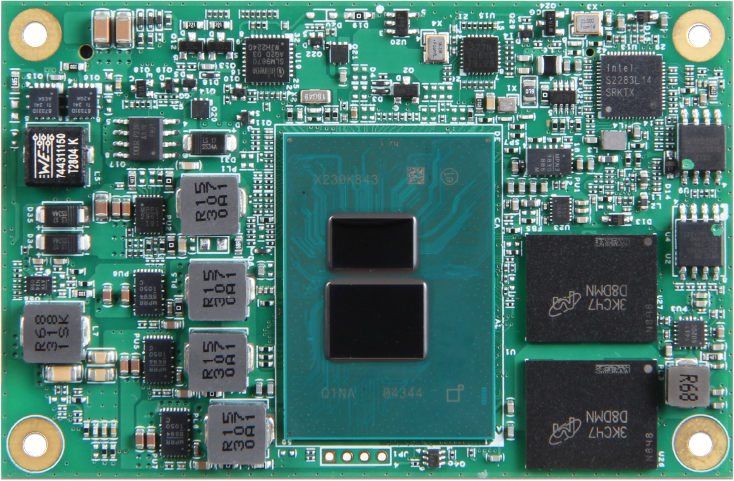
|

|
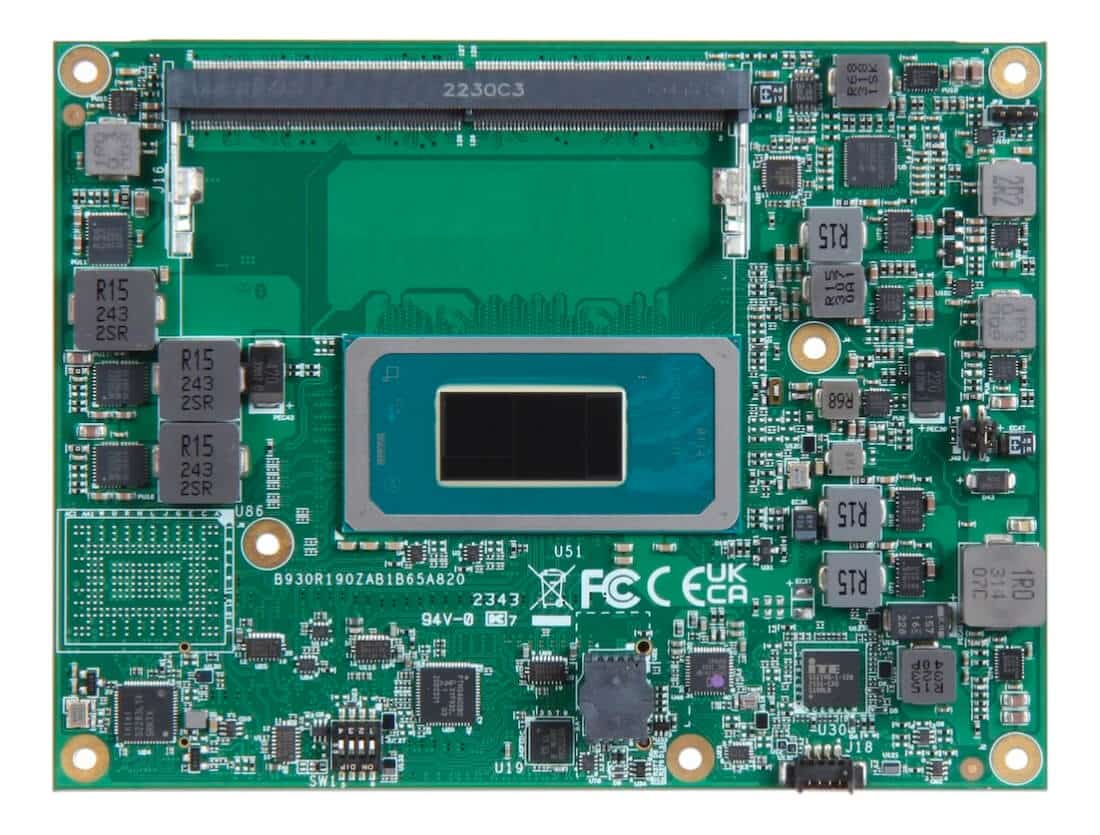
|
| Compact and Efficient for Space-Constrained Deployments |
| PCOM-BA03 |

|
| Type 10 Mini COM Express* 84 × 55 mm |
|
| Integrated GPU for lightweight AI tasks such as basic image recognition and sensor fusion |
| Optimized Performance in a Compact Footprint |
| PCOM-B646 |

|
| Type 6 Compact Size COM Express* 95 × 95 mm |
|
| Integrated GPU for moderate AI workloads including multi-camera vision and real-time analytics |
| High-Performance Computing for Demanding Deployments |
| PCOM-B65A |

|
| Type 6 Basic Size COM Express* 125 × 95 mm |
|
| High-performance CPU with Arc™ GPU and NPU for complex AI workloads, including multi-modal perception and real-time inference |
As humanoid robot technologies evolve at a rapid pace, the market is placing greater emphasis on system reliability, long-term availability, and flexible lifecycle support. This is particularly critical in applications such as warehouse automation and smart manufacturing, where systems must deliver real-time responsiveness, multi-sensor fusion, and sustained operational stability. These complex requirements present new challenges for Design and Manufacturing Services (DMS) providers.
With over 30 years of DMS experience, Portwell offers a comprehensive end-to-end service model that spans from initial demand analysis and technical architecture design to prototyping, hardware development, firmware and driver integration, system testing, certification, mass production, and global delivery. This fully integrated workflow is designed to accelerate product development and deployment cycles.
On the hardware side, Portwell’s engineering team is well-versed in both x86 and ARM platforms. It supports modular integration of AI accelerator cards, multi-camera inputs, and intelligent I/O modules key enablers for humanoid robots performing edge AI inference and sensor fusion in real time.
On the software side, Portwell provides robust integration capabilities across various levels of the stack. This includes microcontroller (MCU) control applications, custom FPGA logic, and Open BMC-based remote management frameworks. The platform also supports AI vision workloads, enabling customers to achieve seamless software-hardware integration from the hardware abstraction layer all the way to application logic. Portwell’s global footprint spans Asia, Europe, and North America, ensuring regional service support and faster communication with local customers. This distributed presence helps clients navigate local regulatory requirements and supply chain dynamics, while ensuring continuity in component availability.
Additionally, Portwell’s large-scale maintenance infrastructure supports Over-The-Air (OTA) update capabilities for real-time software patching and security updates. This reduces manual maintenance efforts and improves system uptime. For applications requiring stringent safety and reliability standards, Portwell also offers customized BIOS-level firmware development ensuring system stability across diverse deployment environments. Through this integrated and value-added DMS model, Portwell delivers a one-stop solution from design and manufacturing to lifecycle management empowering customers to maximize the value of their investment in humanoid robotics.